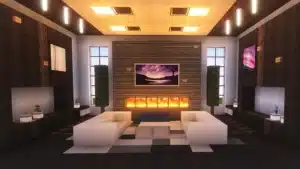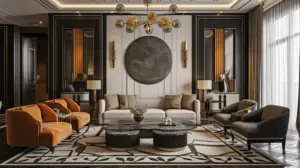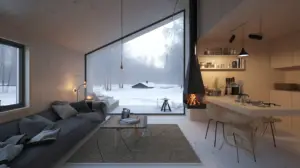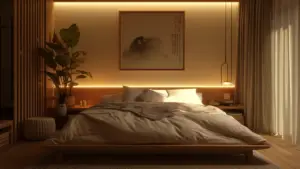Free Shipping On All Orders
60s Interior Design Ideas 2024 You Will Love
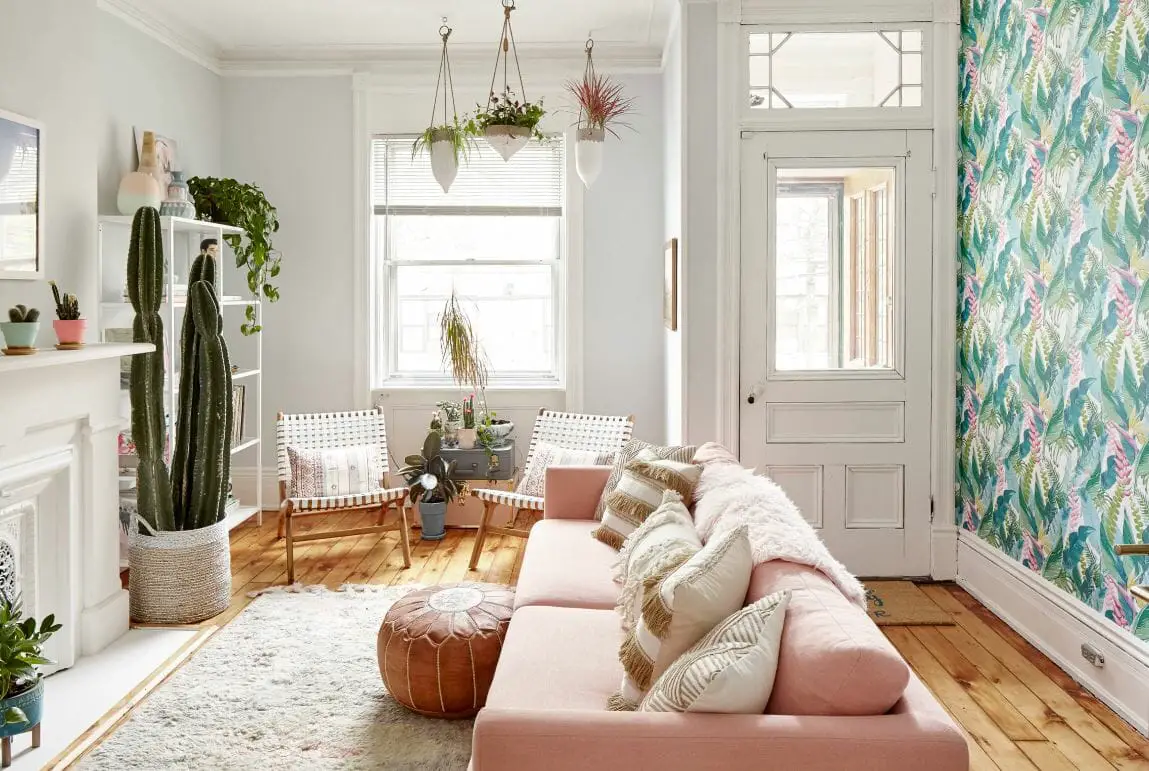
The 60s interior design marked a significant shift in interior design, as people began to break away from traditional styles and embrace bold, colorful, and innovative designs. This decade witnessed an eclectic mix of ideas and materials that transformed the way people thought about their living spaces. From vibrant colors and patterns to groundbreaking furniture designs, the 1960s left an indelible mark on the world of interior design that remains influential to this day.
As the post-war era gave way to a time of experimentation and cultural change, interior designers of the 1960s drew inspiration from various sources, incorporating elements from different periods to create unique and cohesive spaces. The result of this design movement was a surge of creativity that defined the decade with iconic pieces, influential designers, and memorable styles that continue to inspire contemporary designs.
Key Takeaways
- 1960s interior design embraced bold colors, patterns, and innovative materials.
- The decade witnessed a mix of influential designers and iconic furniture pieces.
- The 1960s continue to have a lasting impact on contemporary interior design trends.
Key Designers and Icons
Verner Panton
Verner Panton was a Danish designer known for his futuristic and innovative designs. His most famous piece, the Panton chair, was the first single-form, injection-molded plastic chair ever created. It was nicknamed the “S” chair due to its unique shape, and became a symbol of the era’s dynamic and cutting-edge aesthetic.
David Hicks
David Hicks was a British interior designer who popularized the use of bold patterns and colors. He was a major influence on the geometric shapes and opulent textiles that became synonymous with the 1960 interior design. Hicks was particularly known for his striking use of graphic prints and the innovative way he mixed antique and modern elements in his designs.
Charles and Ray Eames
The husband and wife team of Charles and Ray Eames were American designers who made a significant impact on architecture, furniture design, and the visual arts. Their designs are characterized by clean lines and minimalism, which became hallmarks of the period. Pieces such as the Eames lounge chair and ottoman, as well as their molded plywood chairs, became fixtures in many homes during the 1960s.
Terence Conran
Terence Conran, a British designer, made a substantial contribution to the revitalization of British design during the 1960s. He was instrumental in bringing Scandinavian and modernist influences to the forefront of interior design, promoting the use of clean lines, natural materials, and functional pieces. Conran is best known as the founder of Habitat, a furniture and home furnishings store that made designer products accessible for the average consumer.
Joe Colombo
Italian designer Joe Colombo was a creative force whose work encompassed furniture, lighting, and industrial design. His designs were futuristic, inspired by space-age technology and marked by a playful use of modular shapes. Colombo’s innovative creations, such as the Uovo Lamp and his multi-functional storage systems, were emblematic of the excitement surrounding design in the 1960s.
Andy Warhol
Artist Andy Warhol became synonymous with the 1960s through his groundbreaking work in Pop Art. While not a traditional interior designer, Warhol’s screen-printed art, particularly his iconic images of celebrities like Marilyn Monroe, and everyday objects such as Campbell’s soup cans, had a profound influence on design and popular culture during this time. His art played a significant role in shaping the aesthetic of the era.
Eero Aarnio
Finnish designer Eero Aarnio introduced a new level of creativity and innovation to the world of interior design. He is best known for his Ball Chair and Bubble Chair, which were both launched in the 1960s and became instant design classics. Aarnio’s designs showcased his penchant for using bright colors and bold, sculptural shapes that captured the spirit of the decade.
Key Materials and Furniture
Wood
In the 1960s, wood was a popular material in interior design. Scandinavian influences, especially from Denmark, played a significant role in defining the style of the time. Danish Modern furniture often featured simple, clean lines made from teak or rosewood. Additionally, the decade saw the growing popularity of flat-pack furniture, which allowed for easy shipment and assembly of pieces, contributing to the mass-production of wooden items.
Plastics
The ’60s was a time of experimentation and technological advances, leading to the development of new materials in furniture design. Plastics, for example, were used in various forms: molded, mass-produced, and even in blow-up furniture. Influential Italian design company Zanotta introduced items made of plastic, such as chairs and tables, with a focus on playful, colorful designs.
Metal
Metal was another material prominent in 60s interior design. Futuristic designs from the era often incorporated metal structures, inspired by the space race and 20th-century technological achievements. Examples include the famous Sputnik chandelier, with its radiating metal arms and bright lights, and the Arco floor lamp, with its curved metal arc and marble base.
Ceramics
Ceramics played a minor but significant role in the ’60s interior design scene. Ceramic decorative items provided a touch of sophistication and luxury to homes, often featuring bold patterns and abstract shapes inspired by pop culture. These eye-catching accents complemented the era’s iconic furniture pieces like bean bags and Joker chairs.
Colors and Patterns
The 1960s brought a vibrant and colorful shift in interior design, with different hues and patterns reflecting the social changes of the time. This era saw a departure from formalism and an embrace of eclectic styles that combined various patterns, time periods, and materials.
Orange
Orange was a popular color choice in the ’60s and was often used as a bold accent in interior design. Saturated shades of orange, such as tangerine and burnt orange, could be found in wallpapers, carpets, and upholstery. The flower power movement of the time, which involved the use of vibrant floral patterns and bright colors, also utilized orange tones in conjunction with other lively shades.
Green
Green hues, particularly avocado green, were trending in the ’60s as well. This versatile color was used in various elements of interior design, from curtains and sofas to carpets and wallpapers. Additionally, pea green and drab tones were also popular choices, often complementing other colors in a room.
Yellow
Mustard yellow, a deep and rich shade of yellow, was another popular choice for decorating in the ’60s. This color was great for stand-alone furniture as well as for accent pieces and textiles, providing a bold statement in any space. Wallpapers and carpets in yellow hues, sometimes featuring bold patterns, added warmth and brightness to a room.
Pink
The ’60s saw the popularity of pink shades, particularly fuchsia and other bright tones. Pink was often combined with other bold colors and used in wallpaper, ceramics, and upholstery to create a lively atmosphere. It was not uncommon to see pink hues in kitchens, bathrooms, and even living rooms during this time.
Avocado Green
Avocado green is often considered the quintessential color of the ’60s, representing a sense of optimism and freshness in interior design. This shade of green was used extensively in wallpapers, carpets, curtains, and upholstery, often paired with black and white patterns or other contrasting colors to create a visually striking design.
Popular Styles
Space Age
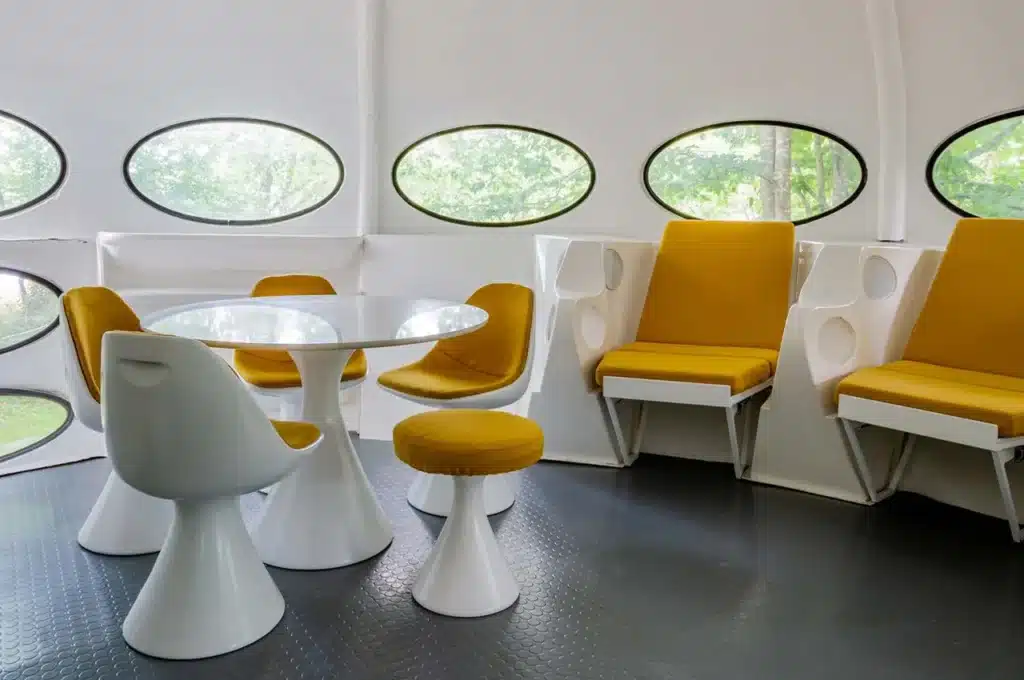
The Space Age was a significant influence on 60s interior design, as it captured the public’s excitement about space exploration and technological advancements. This style featured futuristic shapes, sleek materials, and vibrant colors. Space Age design often included molded plastics, fiberglass, and metal in the creation of unique furniture pieces and accessories. During this era, lighting fixtures were designed with abstract, geometric shapes to mimic the appearance of orbiting planets, giving an otherworldly feel to living spaces.
Hippie Culture
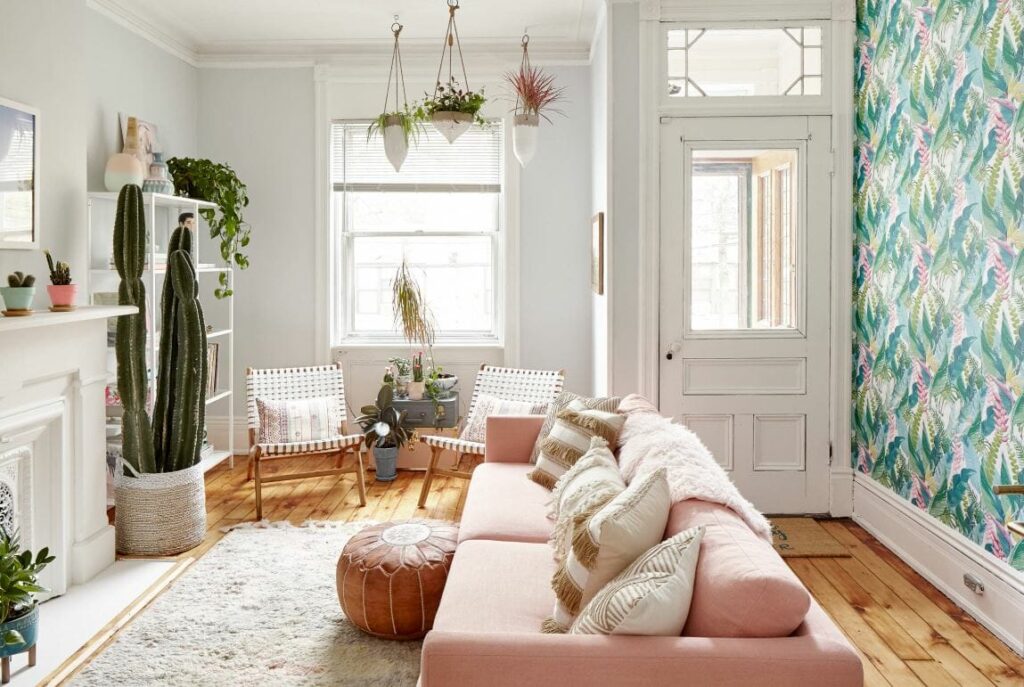
Hippie culture greatly impacted 60s interior design with its bold colors, unconventional materials, and laid-back atmosphere. Bohemian design emerged as a key aspect of this movement, with warm tones, natural fibers, and textured fabrics. The shag rug became a defining home décor item that adorned many bedroom and living room floors, synonymous with hippie aesthetics. Macramé wall hangings and other handmade decorations embodied the free-spirited nature of this movement, incorporating natural elements and vibrant patterns into 60s interiors.
Pop Art
Pop Art was another influential style in 60s interior design, inspired by the rise of pop music and popular culture icons. This art movement used bold colors, geometric shapes, and mass-produced images to create a vibrant and striking aesthetic. Furniture pieces and home accessories often featured bold patterns, contrasting colors, and eye-catching prints, such as those inspired by Pop Art pioneer Andy Warhol. This energetic and playful style quickly found its way into both residential and commercial spaces, adding a lively touch to 60s interior design.
Op Art
Taking cues from the visual arts, Op Art, or optical art, became a popular style in 60s interior design. This style used geometric patterns, contrasting colors, and precise lines to create optical illusions and a sense of movement or depth. In 60s interior design, Op Art typically manifested itself in wallpaper, fabric patterns, and artwork, which added a touch of intrigue and a unique visual experience to a space. As a testament to this style’s popularity, fashion and graphic design also saw the incorporation of Op Art concepts, solidifying its place in the zeitgeist of the 1960s.
Decorative Objects
Home Décor
In the 1960s, home décor saw a rise in the influence of various cultures, particularly due to the growing popularity of foreign travel. Moroccan-inspired décor gained traction, reflected in the use of textiles, rugs, floor pillows, and ornaments. This period also marked an increase in the presence of house plants in homes, which added a touch of natural beauty and freshness to the interiors.
Television became a common household item in the 60s, influencing interior design. Designers kept this in mind while creating living room layouts, with TV sets often acting as the focal point.
Interiors
The 1960s interior designs witnessed an eclectic mix of styles and designs from various periods. Influences ranged from traditional Indian elements to sleek and modern architecture. For instance, Indian motifs became popular, with bright, colorful patterns and textures making their way into home accessories and textiles.
In terms of architecture, open floor plans and large windows were prominent features that contributed to spacious and well-lit interiors. Bold colors, innovative materials, and geometric patterns were also hallmarks of this decade’s design aesthetic.
Pieces
Iconic pieces from the 1960s include a variety of objects that showcased the era’s inventive spirit. For example:
- Eero Aarnio’s Ball Chair: This spherical chair, made of fiberglass and featuring a futuristic design, became an emblem of 60s modernism.
- Arco Floor Lamp: Designed by the Castiglioni brothers, this iconic lamp combined style and functionality. Its impressive arc and marble base made it a statement piece in any room.
- Eames Lounge Chair: Known for its timeless design, Charles and Ray Eames’ lounge chair featured a plywood shell, leather upholstery, and a cozy, comfortable feel that made it an instant classic.
The 1960s was a decade of experimentation in interior design, resulting in a diverse range of decorative objects and architectural elements that continue to inspire today’s designers and homeowners alike.
Living Spaces
Living Rooms
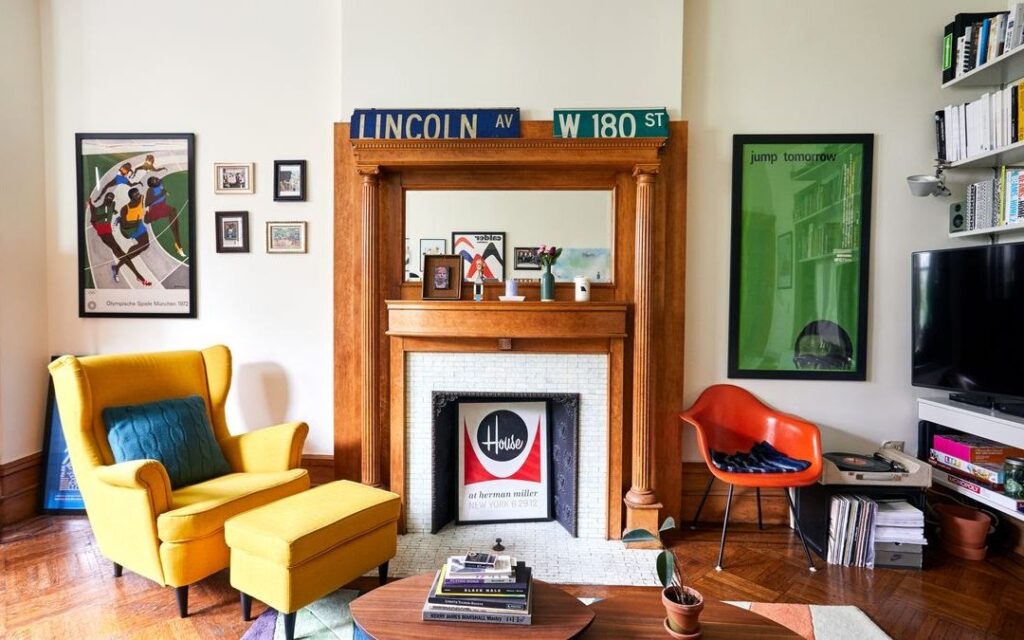
The 1960s was a decade of experimentation and boldness in interior design, greatly influenced by the cultural and social changes of the time. One of the most distinct features of 1960s interior design living spaces, especially in living rooms, was the emphasis on clean lines and geometric shapes. This can be seen in various furniture designs and architectural elements, such as the iconic Eames lounge chair, which incorporated both form and function into its design with its sleek look and comfortable seating experience. Eames lounge chair.
The use of bold, geometric patterns in living rooms was another hallmark of the 60s interior design, with patterns often found on rugs, cushions, and wallpaper. These eye-catching designs helped establish a sense of visual harmony and continuity within the space. Furthermore, warm tones, natural fibers, and textured surfaces were often incorporated into living rooms, reflecting the growing interest in creating a more comfortable and inviting atmosphere. Boho design.
The integration of technology into living rooms began in the 1960s as well, with more households embracing TV sets, stereo systems, and other electronic appliances. The inclusion of cutting-edge technology within living spaces paved the way for a more modern and connected home experience. It was during the 60s that people began to place more emphasis on the balance between aesthetics and technological functionality in their homes.
Incorporating 1960s interior design elements into today’s living spaces can create a retro-modern look that blends history and contemporary trends. To achieve this, consider incorporating the following aspects from the decade:
- Clean lines in furniture and architectural elements
- Geometric patterns on rugs, cushions, and wallpaper
- Warm tones, natural fibers, and textured surfaces
- Unobtrusive integration of the latest technology
By focusing on these key elements, you can create a living space that nods to the past while remaining current and functional.
Contemporary Relevance and Influence
The 1960s was a time of experimentation and creativity in interior design, with several trends and concepts still influencing today’s modern homes. During this time, the growing popularity of foreign travel sparked the incorporation of different cultures in home design, particularly Moroccan-inspired décor. This trend can still be seen today through the use of textiles, rugs, floor pillows, and ornaments.
Advancements in molded plastics and nylon production during the 1960s led to the creation of innovative and unique furniture designs. These elements remain relevant in modern design through sleek and futuristic forms. According to Nostalgia Central, some surreal furniture pieces included chairs in the shape of a set of teeth and designs that exhibited a fetishist’s dream. These designs, although extreme, showcased the importance of artistic expression and experimentation in interior decorating.
As a response to the postwar era, the ’60s trend leaned towards non-conformism, and people sought to experiment with their living spaces. Bold patterns, bright colors, and unusual shapes became popular, making a lasting impact on contemporary design trends. To this day, many people incorporate 60s interior design elements like these into their homes to create a vibrant and unique look.
Frequently Asked Questions
What colors were popular in 60s interior design?
The color palette of the 1960s included bright hues such as orange, yellow, and green, as well as muted shades like avocado, brown, and beige.
What furniture was popular in 60s interior design?
Popular furniture styles included molded plastic chairs, modular sofas, and space-age designs. Patterns like paisley and floral were also common.
What materials were used in 60s interior
design?
Materials like shag carpet, vinyl, and chrome were popular in 60s
interior design. Natural materials like wood and rattan were also used, often in combination with bright colors and bold patterns.
If you liked this post about 60s interior design, don’t forget to follow us on Pinterest so you don’t miss any more interior design news!


